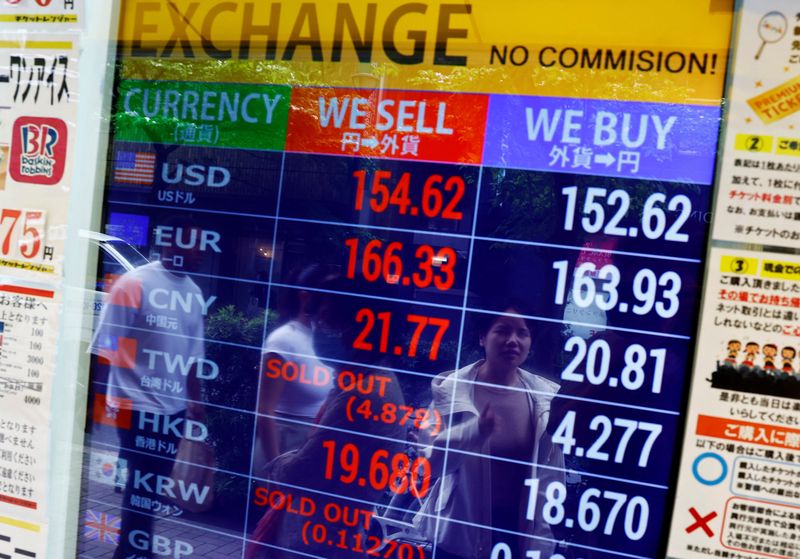By Leika Kihara
TOKYO (Reuters) -The Bank of Japan's decision to keep policy unchanged last week gave yen bears plenty of sell cues, but largely overlooked in the stampede were signals the central bank could raise rates in several stages in years ahead, with a hike possible in autumn.
The yen hit a fresh 34-year low as markets focused on the BOJ's decision on Friday to keep interest rates around zero and a lack of signals from Governor Kazuo Ueda that the currency's falls may quicken the timing of the next rate hike.
BOJ watchers say while the central bank's quarterly report and comments from Ueda clearly suggest consecutive rate hikes are on the table, its failure to effectively communicate its policy intentions has exacerbated the yen's selloff.
In the quarterly report released on Friday, which serves as a basis for long-term monetary policy, the BOJ projected inflation to stay around its 2% target in the next three years, and said price growth was likely to be at "a level generally consistent" with its target from around late 2025.
The report also included for the first time language that the central bank would "adjust the degree of monetary accommodation" - code for rate hikes, according to BOJ watchers - if the economy and prices meet projections.
"Taken together, the BOJ is essentially declaring it has a consecutive rate-hike plan in mind," said former BOJ official Nobuyasu Atago, who expects the next hike to come in September.
"It's clear the central bank is steadily laying the groundwork for a rate-hike path that could take short-term rates up to around 1% by the end of 2026," said Atago, currently chief economist at Rakuten Securities Economic Research Institute.
While ignored by traders who were looking for stronger warnings on the weak yen, Ueda said the BOJ could preemptively hike rates if the boost to inflation from the currency's declines persists and affects corporate wage-setting behaviour.
"Recent yen falls won't start to materially affect inflation until around autumn this year," said a source familiar with the BOJ's thinking.
"In sum, the BOJ is signalling there's a pretty good chance the next rate hike will come around that time," the source said.
COMMUNICATION FUMBLE
Having ended eight years of negative interest rates and other remnants of its massive stimulus programme in March, the BOJ now sets the short-term policy rate in a 0-0.1% range.
Many market players expect the BOJ to raise the rate to 0.2% or 0.25% later this year, though they are divided on how quickly it could move thereafter.
In a sign the BOJ might not wait too long after its next hike, Ueda said he expects short-term rates to rise near Japan's neutral rate of interest - seen by many economists as being anywhere between 0.5% and 1.5% - around late 2025 through 2026.
"If one were to take the report and Ueda's comments at face value, the BOJ's short-term target rate could reach 1% in the latter half of fiscal 2025," said Naoya Hasegawa, chief bond strategist at Okasan Securities Research.
The BOJ currently does not disclose its estimates on Japan's neutral rate of interest, which is the rate at which monetary policy is neither contractionary nor expansionary.
But Ueda said last month the BOJ will be "extracting insights on the neutral rate" in the process of raising rates.
He also said on Friday the BOJ would continue work to narrow the estimated neutral rate, suggesting the level would be crucial not just in judging the pace of future rate hikes but the bank's communication on the monetary policy outlook.
Former BOJ board member Takahide Kiuchi said the BOJ could publish the board's median estimate on the neutral rate in the future as guidance for markets on the rate hike path.
"Any such guidance could push up long-term yields and slow yen falls. But it's not a tool that can be used easily as rising yields could also push down stocks," he said.
The market's dovish interpretation of Ueda's comments accelerated the yen's declines that led to suspected yen-buying intervention by Japanese authorities on Monday.
There are no guarantees more explicitly hawkish BOJ signals would ease the massive downward pressure on the yen given the other factors bearing on the currency.
However, the BOJ's failure to get its hawkish message across underscores the communication challenge it faces in countering yen bears, particularly with the Federal Reserve seen keeping U.S. interest rates high for longer than expected.
"The governor was perhaps being too honest and sincere in explaining how the weak yen could accelerate inflation only in the long run," said Kiuchi, who is now executive economist at Nomura Research Institute.
"He could have issued a stronger warning against the negative impact of the weak yen," he said. "It was a communication error on the part of the BOJ."
